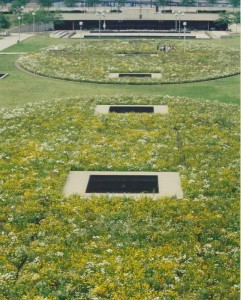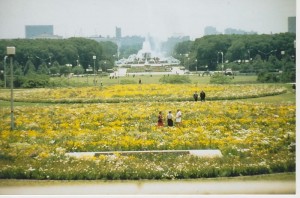Chapman Kelley Launches “Wildflower Works” Foundation
This letter from artist Chapman Kelley was shared by the Council for Artists Rights. It will be of interest to those of you who visit Chicago. See also this interesting article about the “wildflower painting” that was savaged by the Chicago Parks Department, resulting in a lawsuit.
=========================================
December 14, 2015
Season’s greetings! I am pleased to announce the launching of the Chapman Kelley Wildflower Works Foundation. Earlier this year the Internal Revenue Service approved the Foundation as a tax-exempt nonprofit under section 501(c)(3) of the I.R.S. code. Olan Hankins PhD and John A. Viramontes have joined me in establishing the Foundation. We are currently assembling board and committee members.
The Foundation will allow for greater participation in the movement to, among other things, educate the public how to transform the current water-guzzling landscaping to all-indigenous plant species, otherwise known as native plants. It is an idea I pioneered in 1976 via my Wildflower Works SM (U.S.A. Service Mark) (WW) concept. One very important result of such landscaping will be the conservation of a most precious scarce resource: potable water.
As such, this thrust will entail a public relations effort along with information sessions and presentations for those not familiar with the concept. Our landscape professionals, physical scientists and others will share their knowledge and the “hard facts” of how this effort will help alleviate environmental damage. The Foundation will provide free lectures in addition to ongoing video segments to be available on our forthcoming website. Essentially, people will walk away empowered to change the world.
Once implemented, the changed landscape will lead to what we conservatively estimate to be 50% in water savings for the average homeowner and others. This immediate economic savings can then be reinvested to re-landscape, thus paying for itself!
In recent decades three leaders, U.S. Presidents, have publicly stepped forward in support of potable water conservation and sustainability, thereby making people aware of global ecology.
On February 3, 1999, U.S. President Bill Clinton signed Executive Order 13112 which strongly champions native plants. The Executive Order established a permanent Advisory Committee representing stakeholders and includes seven cabinet members. The profound importance of that Order can be found in Jason and Roy Van Driesche’s book, Nature Out of Place: Biological Invasions In The Global Age. And for the first time in presidential library history, the William J. Clinton Presidential Library has an energy saving “green” roof on it. The George W. Bush Presidential Library and Museum saw the wisdom in the Clinton design priorities and followed suit by landscaping its grounds with plants indigenous to North Texas.
On a Chicago South Side site proposed by the University of Chicago, the Obama Presidential Library and Museum will adhere to the Obama Foundation’s landscape requirement having clear language in it guaranteeing it will consist of plants native to Illinois. Obviously, indigenous plants are a significant aspect of the three presidential libraries’ design. It is not difficult to see how each of these Presidents fundamentally endorse my WW concept; we are definitely on the same page!
It is uncanny that predating Clinton’s Executive Order 13112 by 23 years, in March of 1976, I pioneered the WW concept, an idea which coupled science and art in landscaping using plants indigenous to an area. My celebrated WW environmental paintings were created in Texas and Illinois. The non-commissioned Chicago Wildflower Works 1984 – 2004 (CWW) proved to be a haven for natural pollinators and required no plant fertilizer or insecticides. It thrived solely on rainwater, used no potable water and bloomed across three seasons a year. Much to the delight of photographers and casual passersby, during the winter months the CWW stood as a snow-laced tawny sculpture of varying height and thickness. All of this was made possible by prominent residents Bonnie and John Swearingen, (he, a business tycoon) who in the early 1980s invited me to move from Texas to create CWW, located in lakeside Grant Park. That environmental painting was a 66,000 sq. ft. sustainable public artwork utilizing solely plants native to Illinois and it saved Chicago taxpayers $6.6M in maintenance across 20 years, plus unused potable water savings. All of this could not have been accomplished without the help of the many unpaid and dedicated volunteers working under my direct supervision.
One such volunteer is the late Lawrence “Larry” Clark. He was one of CWW’s earliest helpers. Larry has passed on to the Foundation, through his close friend, Debbie Marlett, an attractive five-acre parcel of land located near the Indiana-Illinois border in the town of Morocco. A conversion to landscaping consisting of native Indiana plants is envisioned for the property.
Chicago was the perfect place to be the site of the most important artwork of my life, my CWW. And why Chicago? Simply because it has long prided itself on its efforts to restore and maintain its heritage of prairie land through scientific study and effort. Scientists who were so helpful to our CWW have stepped up their studies.

Chicago Wildflower Works 1984 - 2004, a non-commissioned environmental painting. View is north, Randolph St. is in the distance. Photo courtesy Chapman Kelley
University of Delaware professor Dr. Douglas Tallamy’s book, Bringing Nature Home is an excellent guide as seen through the eyes of a professional entomologist. Another highly recommended book by Charlotte Adelman and Bernard L. Schwartz is The Midwestern Native Garden: Native Alternatives to Nonnative Flowers and Plants, an Illustrated Guide. And Prairie Moon Nursery’s seed and plant catalog offers valuable information, more than we have found in the past of almost 40 years.
I am flattered for having had almost 40 years of academic, governmental and news media attention given to my WW concept. However, despite the many people and organizations involved in the “ecology” movement, the environmental advantages of such an idea have not yet been fully addressed.
Laura Quattrocchi, native plant specialist, observed that some serious work is involved with such an planet-friendly landscaping. She said, “It seems that most people feel that if they throw some wildflower seeds over their shoulder, they will have an instantly sustainable and gorgeous landscape that will never require watering, mowing and maintenance. And that somehow, magically, water savings will happen the next day.” Instead, to save an appreciable amount of water, everyone must exchange their exotic non-native plants for a totally indigenous landscape.
I am only a painter, however, having been a delegate to the 16th United Nations Educational, Scientific and Cultural Organization (UNESCO) conference on Man and the Biosphere Programme in the early 1970s, I realized a great amount of scientific guidance would be necessary to realize my WW concept. Without my main range scientist the late Thomas Jefferson Allen PhD, we could not have accomplished all that we did in Chicago.
We need not wait for the government to legislate common sense landscape practices. The public of Chicago and government officials were largely aware of the importance of the prairie as our source for indigenous plant material. Prairie restoration and conservation scientists were of inestimable help for the CWW. Now we have scientists organizing so their collective opinions can be passed on to the public at large, thereby fueling a grassroots movement.
I have recently spent a good bit of time being hospitalized. I am now ready to “get back in the saddle” to finish my WW concept by taking it to the public.
I intend to give my all to this effort, and pledge everything I have and will have for this cause. Hopefully, this effort will spill over to reinvigorate the art world. Thus my own paintings and the drawings of the late Frank A. Jones, the renowned outsider artist (featured in TIME Magazine April 28, 2014), whose Estate I own, are available for purchase to benefit the Foundation. I expect to die a penniless gentleman in order to fulfill the potential of the WW concept.
In closing, even the First Lady, Lady Bird Johnson, penned a personal note to me in the early 1980s, “You are the real pioneer!” regarding my Wildflower Works concept.

The non-commissioned public art, Chicago Wildflower Works 1984 - 2004 in historic lakeside Grant Park. View is south with magnificent Buckingham Fountain in the distance. Photo courtesy Chapman Kelley.
Your much appreciated, tax deductible donation, in any amount, may be made payable to the Chapman Kelley Wildflower Works Foundation.
Send your remittance to:
Chase Bank
Chapman Kelley Wildflower Works Foundation
1204 E. 53rd St.
Chicago, IL 60615
I have recently returned to Illinois. My studio and residence is in the historic Hyde Park – Kenwood community in Chicago.
Chapman Kelley
1030 E. 49th St.
Chicago, Illinois 60615
Cell 312-731-6515 (preferably before 8:00 p.m. CST)
Email: chapmankelley@chapmankelley.com
Website: chapmankelley.com
My Memoir: Chapter 1 – 15
Feel free to forward this email to whoever you feel might be interested in knowing more.
All the best,
Chapman
